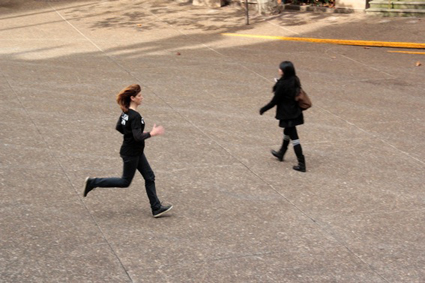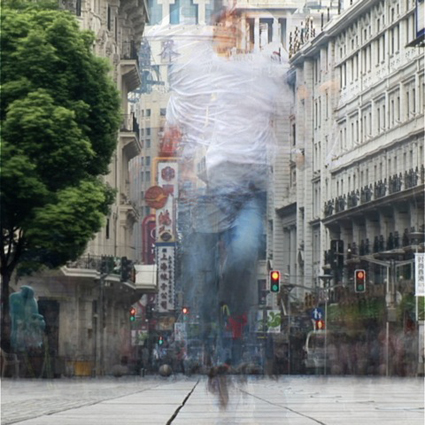Run for your lives [2]
Keith Gallasch, Running the City, COFA, UNSW

MAP Office, still from flash run, 2013, site specific performance, 4:33 mins
courtesy the artists
MAP Office, still from flash run, 2013, site specific performance, 4:33 mins
As an invitation to ‘run the city’ Marnix de Nijs ‘s Run Motherfucker Run (see Run for your lives [1]) is attractive, but some of its spooky, empty locations suggest its machine is safer, unless you find it’s interactivity unsettling. Then it’s a bike for you, or a walk. But look out for the kinds of runners seen in MAP Office’s Runscape, who pelt through the streets and byways of Hong Kong, darting past walkers and parkour-ing over balustrades.
Map Office (Gutierez + Portefax), Runscape
MAP Office’s Runscape comprises a triangular installation, each exterior screen wall focused on a city: Hong Kong, Berlin and Sydney. For Hong Kong the artists have created a 25-minute video work. You can exercise vicariously by watching two males cover an enormous amount of Hong Kong space, the continuity of their running apparently seamless but clearly the result of very careful camera set-ups with numerous points of view. A voiceover evangelically extols the virtues of running: it will yield “a new aesthetics”; it has an outlaw quality, being regarded “with suspicion…but it’s not illegal”; and it’s “a bullet that needs no gun” in a city “like a pinball table.” Although its pop-theorising-‘running off at the mouth’ is aurally tiring, Runscape is invigoratingly visceral to watch (if fearing for pedestrians that ‘running the city’ doesn’t take on big time).
The marginally interesting Sydney component of the work comprises runner point-of-view and other shots playing out at normal and slow motion speeds on a bank of small monitors. On the Berlin side of the installation are strips of images, representations of running in films. Among these are occasional gnomic quotations citing “cinema as urban planning” and “the real seen as décor for future fiction,” while describing the runner as “mov[ing] through the static frames of film, unlocking a visual improbability.” Set among these are video monitors showing movie excerpts including, not surprisingly, Run Lola Run.
Jun Nguyen-Hatsushiba

Jun Nguyen-Hatsushiba, still from 49 Meters 49 Times: A Rehearsal with Entities in Shanghai, 2010, HD digital video, 1 mins.
courtesy the artist and Mizuma Art Gallery, Tokyo
Jun Nguyen-Hatsushiba, still from 49 Meters 49 Times: A Rehearsal with Entities in Shanghai, 2010, HD digital video, 1 mins.
Jun Nguyen-Hatsushiba’s enticing video 49 Meters 49 Times exhibits a runner advancing on the viewer, but manipulated in such a way that the subject is semi-transparent, flickering until disappearing in near close-up. Even more ghostly are pedestrians, grey-ish floating figures who offer no hindrance. As in Runscape, they are incidental presences, if in a work more magically engaging.
Elsewhere in the two spaces devoted to Jun Nguyen-Hatsushiba’s running-inspired works are maps of cities, rather quaintly evoking a sense of urban ecology, and a photo series of the artist and others moving through a variety of landscapes (some in a state of ruin; some rural) in a multitude of countries. Again there’s an inescapable sense of evangelicism and ‘depopulation.’
Brad Miller & Ian MacArthur, #capillary
In this very widescreen work, rows of varying depths featuring still images of Sydney travel horizontally in opposite directions, come momentarily to rest and then glide on with a liquid restlessness which is occasionally heightened by a distorting watery bubble pulsing out of an image. The photographs come in fascinating clusters, juxtaposing black and white images of an old building, aggregating graffiti, flowering shrubs and trees, aeroplanes, communal walks (yes, actual people), rusted signage, harbour parks, bicycles—nothing is too humble for this lateral kaleidoscope. With its ethereal sound score, #capillary is an engaging meditation on a multi-faceted city and the ways in which we take it in, here via a vast moving image comprising a multitude of stillnesses, evoking a flaneur with a camera.
Richard Goodwin & Russell Lowe, Crysis in Parasite Paradise
Crysis in Parasite Paradise (2013) is a strikingly critical work in Running the City, although critiques are inherent in the advocacy of other works in the exhibition. A small room is dominated by a huge maquette of a futuristic Sydney, its older buildings, like the Town Hall and Queen Victoria Building dwarfed by bland, largely identical office towers. These are linked by gun-metal grey conduits and tracks that suggest the militarisation of the city—the components clearly made from plastic war toys. More disturbing is the presence of helicopters jammed into walls and hovering on the edge of building tops as if about to plummet. Sitting at a computer, you can mouse your way through the same city with vertiginous swoops, ambles to the harbour’s edge and through building interiors. The digital detailing, as in the maquette, is not complete, nor doubtless intended to be. What you experience is a sense of not just heritage buildings being buried in the dark, but our own miniaturisation and powerlessness in what looks like a battleground.
Running the City offers a fascinating look at ways of seeing and connecting with the world we have built around ourselves, ranging from direct engagement to quiet reflection. Walking, bicycling and running are gaining increased traction, socially and politically, alongside growing public concern and action over town planning, so it’s not surprising that works about our physical, and virtual, engagement with the city should come with a sense of romance and idealism (save for Goodwin’s contribution), individualism and even transcendence, if sometimes feeling less than communal. However, a ‘flash run performance’ led by MAP Office did, it seems, offer a sense of running the city together—engaging with it and shaping its future.






